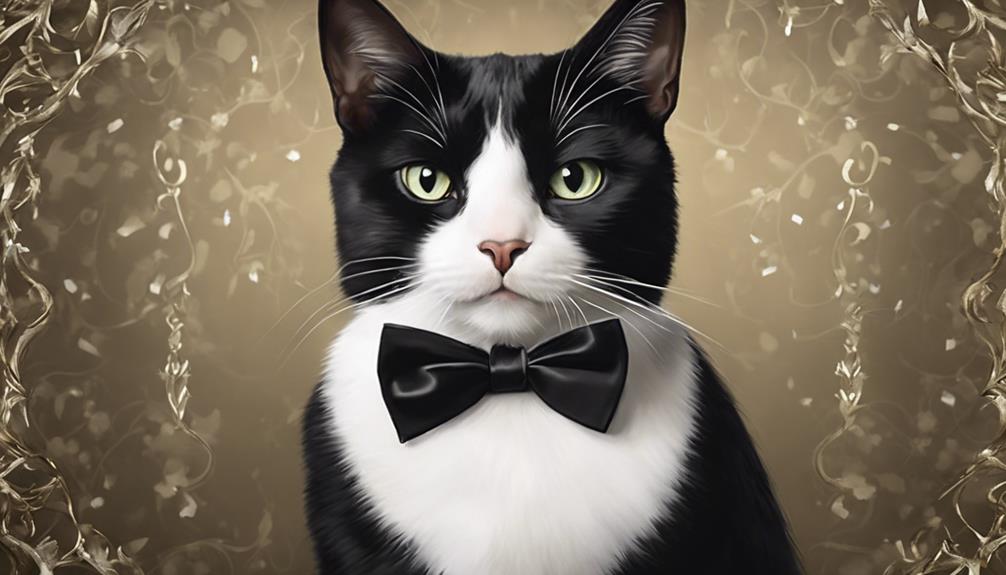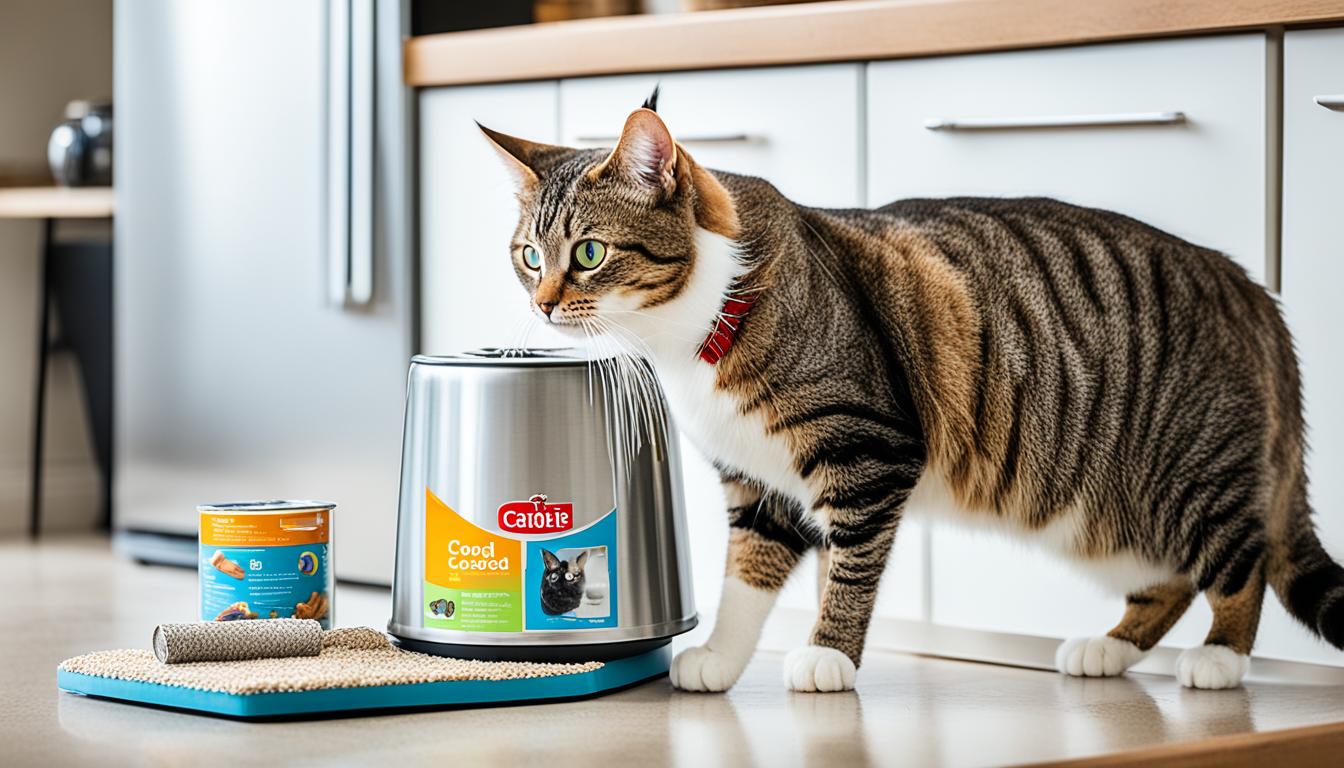When choosing tuxedo cat names, consider options from various categories for a perfect match. Classy and Elegant names like Duchess, Prince, and Queenie exude glamour. Famous Celebrity-Inspired names such as Clooney, Hepburn, and Bardot add sophistication. Playful and Quirky names like Whiskers, Buttons, and Pudding bring fun to your feline's identity. Sophisticated picks like Winston, Audrey, and Marquis highlight their formal appearance. Patterns-Based names such as Oreo, Panda, and Midnight emphasize their coat patterns. Dapper names elevate their style, while Vintage-Inspired names bring elegance. Mythical and Mystical names infuse magic, and Whisker-licious names highlight their charming features. Explore these categories to find the purrfect name for your tuxedo cat!
Key Takeaways
- Classy and elegant names like Duchess and Prince add glamour to your tuxedo cat's identity.
- Playful and quirky names such as Whiskers and Buttons bring fun and charm to your cat's persona.
- Dapper names like Winston and Audrey elevate the sophisticated image of tuxedo cats.
- Vintage-inspired names exuding elegance, like Marlowe and Gatsby, give your cat a timeless appeal.
- Mythical and mystical names like Merlin and Luna infuse magic and wonder into your tuxedo cat's name.
Classy and Elegant Tuxedo Cat Names
When selecting names for classy and elegant tuxedo cats, we often aim to capture the regal essence of their black and white coats. These felines exude sophistication and style, making it fitting to choose names that reflect their refined appearance.
Popular choices for these classy tuxedo cats include Duchess, Prince, and Queenie, which not only sound elegant but also highlight the regal nature of these beautiful creatures. Owners who opt for classy and elegant tuxedo cat names add a touch of glamour and charm to their already stylish pets.
Famous Celebrity-Inspired Tuxedo Cat Names

Drawing inspiration from famous personalities, we explore the world of celebrity-inspired tuxedo cat names. When choosing a name for your tuxedo cat, why not opt for a touch of glamour with a celebrity-inspired twist? Names like Clooney, inspired by the suave George Clooney, exude sophistication. Hepburn, paying homage to the elegant Audrey Hepburn, adds a classic charm to your feline friend. For a touch of French flair, consider Bardot, reminiscent of the iconic Brigitte Bardot.
These names not only reflect the grace and style associated with celebrities but also provide a fun way to honor your favorite stars while naming your beloved pet. Imagine calling out your cat's name and feeling a connection to the glitz and glam of Hollywood. So, if you're looking to add some star power to your tuxedo cat's identity, a celebrity-inspired name could be the perfect choice.
Playful and Quirky Tuxedo Cat Names

Let's explore some playful and quirky tuxedo cat names that perfectly suit these charming felines. Tuxedo cats have a unique appearance that often inspires creative name choices. Names like Whiskers and Buttons are popular because they reflect the playful and quirky nature of these cats.
Imagine calling out to your cat named Pudding or Sprinkles; it adds a touch of fun and whimsy to your furry friend's identity. Names like Snickers or Whiskers can highlight the charming and mischievous personality that many tuxedo cats possess. Buttons and Sprinkles are also unique name options that capture the cute and playful essence of these felines.
Choosing a playful and quirky name like Pudding or Sprinkles can bring out the fun-loving side of your tuxedo cat, creating a special bond between you and your beloved pet. So, get creative and find a name that truly fits your tuxedo cat's one-of-a-kind personality!
Sophisticated Tuxedo Cat Names

When contemplating sophisticated tuxedo cat names, it's crucial to think about elegance and charm. Classic black-and-white options like Winston or Audrey can add a touch of sophistication to your feline companion.
Distinguished feline monikers such as Marquis can highlight the regal appearance of tuxedo cats.
Elegant Name Suggestions
In our search for the perfect name for our sophisticated tuxedo cat, we aim to encapsulate their regal essence with an elegant moniker that exudes grace and charm.
When considering a distinctive black and white name for your cat, think of elegant options like 'Duchess,' 'Sir Reginald,' or 'Lady Penelope.' These names not only reflect the formal and classy appearance of tuxedo cats but also add a touch of sophistication to your feline companion.
Choosing an elegant name can highlight the refined nature of your tuxedo cat and capture their regal essence. Sophisticated names like these can truly bring out the grace and charm that make your tuxedo cat stand out as a distinguished member of your family.
Classic Black-and-White Options
When naming sophisticated tuxedo cats with a classic black-and-white coat, consider opting for timeless and classy names that reflect their sleek and dapper appearance. These felines exude elegance and style, making names like Oreo, Duchess, or Felix perfect choices.
The black-and-white contrast of their fur inspires classic monikers that stand the test of time, honoring their formal attire-like markings. Picture your refined kitty strutting around with a name that's as suave as they are.
Whether you choose to go with a name that's a nod to their formal look or something that embodies their sophisticated aura, make sure it resonates with their distinguished image. Your tuxedo cat deserves a name that's as sharp and stylish as they are.
Image Credit: Unsplash
Distinguished Feline Monikers
Moving from classic black-and-white options to distinguished feline monikers for sophisticated tuxedo cats, the focus now shifts to names that exude elegance and charm, reflecting their formal appearance. These distinguished names emphasize the regal nature and unique style of tuxedo cats, making them stand out with sophistication and refinement. Owners often choose these names to highlight the cat's classy demeanor and elegant aura. To help you find the perfect sophisticated name for your tuxedo cat, here are some examples in the table below:
| Moniker | Meaning |
|---|---|
| Sir Winston | Evokes authority |
| Duchess | Reflects grace |
| Lord Theodore | Elegance personified |
Tuxedo Cat Names Based on Patterns

When choosing tuxedo cat names based on patterns, we focus on the unique blend of black and white fur. These names often emphasize the classic contrast and symmetry found in tuxedo cats' coat designs.
Popular choices like Oreo and Panda highlight the elegance of these pattern-inspired names.
Unique Pattern Combinations
In our experience, tuxedo cat names inspired by their unique coat patterns offer a charming and personalized touch to these stylish felines. When naming a tuxedo cat based on their distinctive pattern combinations, consider the following:
- Black Dominance: For tuxedo cats with more black fur than white, names like 'Midnight' or 'Shadow' can highlight their darker coat dominance.
- White Accents: Tuxedo cats with prominent white areas on their chest, paws, or belly could be named 'Snowflake' or 'Marshmallow' to emphasize their white accents.
- Balanced Contrast: If your tuxedo cat has an equal distribution of black and white fur, names like 'Oreo' or 'Panda' can reflect the harmonious contrast in their coat pattern.
Classic Black and White
Our exploration of tuxedo cat names now shifts to the domain of 'Classic Black and White,' focusing on names inspired by their timeless coat patterns.
Tuxedo cats sport a distinctive black and white coat pattern that resembles a formal suit, with white paws, chest, and belly contrasting against a black back and head. This classic coloration gives tuxedo cats a dapper and sophisticated appearance, making them stand out in any room.
The black and white pattern is a common and recognizable trait among tuxedo cats, highlighting their elegant and formal aesthetic. When choosing a name for your tuxedo feline friend, drawing inspiration from this classic black and white palette can emphasize their stylish and refined nature.
Unique Tuxedo Cat Names

Reflecting the individuality and charm of your tuxedo cat, unique names inspired by various sources such as nature, literature, or mythology can add a distinctive touch to your feline friend. When choosing a name for your tuxedo cat, consider options that stand out and capture the essence of their personality.
Here are some ideas to get you started:
- Zephyr: This name, inspired by the gentle breeze, is perfect for a serene and elegant tuxedo cat who moves with grace and poise.
- Luna: Drawing inspiration from the moon, Luna is a mystical and enchanting name for a cat with a mysterious and alluring presence.
- Maverick: For a bold and adventurous tuxedo cat who loves to explore and push boundaries, Maverick is a fitting choice that exudes confidence and charisma.
Unique names like these not only set your tuxedo cat apart from the rest but also add depth and character to your beloved companion. Choose a name that resonates with you and captures the essence of your feline friend's one-of-a-kind spirit.
Dapper Tuxedo Cat Names
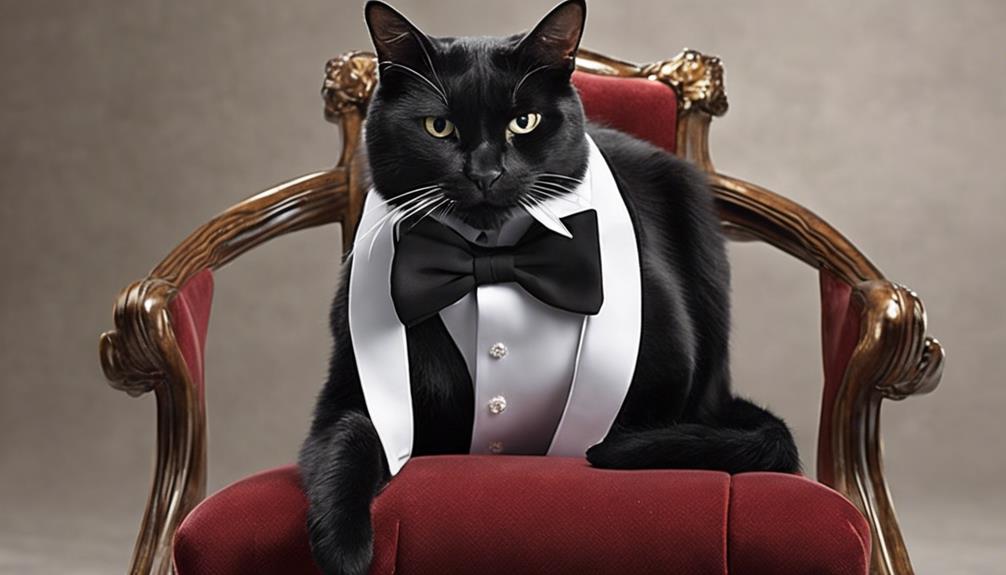
Exploring stylish monikers for your tuxedo cat can elevate their sophisticated image and complement their elegant appearance. Dapper tuxedo cat names like 'Benedict Cummerbund' and 'Tabitha Tuxedo' add a touch of sophistication and charm to your feline companion. Drawing inspiration from iconic figures such as 'The Penguin' and 'Marlene Dietrich,' known for their stylish tuxedo ensembles, can bring a sense of glamour to your cat's persona.
Opting for a dapper tuxedo cat name not only reflects your cat's formal and distinguished appearance but also adds a fun and unique element to their character. These names can capture the essence of your cat's classy demeanor while setting them apart with a touch of elegance.
When selecting a dapper tuxedo cat name, consider names that resonate with their refined coat pattern and debonair presence. With the right moniker, your tuxedo cat can embody a sense of sophistication that's sure to turn heads and capture hearts.
Vintage-Inspired Tuxedo Cat Names

Delving into the charm of yesteryears, vintage-inspired tuxedo cat names bring a touch of nostalgia and elegance to your feline friend's persona. When choosing a name for your dapper tuxedo cat, consider these vintage-inspired options:
- Winston: This classic name exudes sophistication and refinement, perfect for a distinguished tuxedo cat with a regal air.
- Felix: A timeless choice that harkens back to a bygone era, Felix is a name that oozes charm and charisma, fitting for a suave tuxedo cat.
- Audrey: Inspired by the iconic Audrey Hepburn, this name brings a touch of elegance and grace to your tuxedo cat, capturing a sense of timeless beauty.
Vintage-inspired tuxedo cat names not only showcase your cat's unique style but also add a sense of history and class to their identity. Whether you choose Winston, Felix, Audrey, or another vintage gem, your tuxedo cat is sure to exude charm and sophistication with a name that stands the test of time.
Mythical and Mystical Tuxedo Cat Names
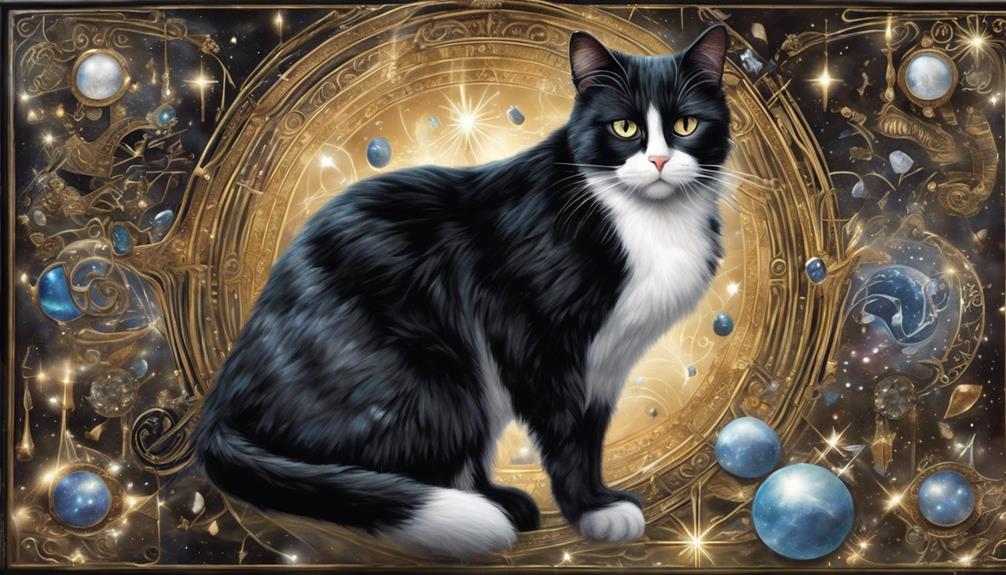
Drawing inspiration from legendary creatures and folklore, mythical and mystical tuxedo cat names infuse a sense of magic and mystery into your feline companion's persona. Names like Merlin, Athena, Loki, Freya, and Apollo embody the enchanting nature of tuxedo cats, adding a touch of whimsy to their identity.
By choosing a mythical name for your tuxedo cat, you can give them a unique and spellbinding moniker that reflects their mystical aura. These names not only sound intriguing but also serve as a conversation starter, showcasing your cat's charm and individuality.
Whether your cat is mischievous like Loki or wise like Athena, a mythical tuxedo cat name can enhance their allure and create a sense of wonder for those around them. So, consider delving into the world of legends and myths to find the perfect name that captures the magical essence of your tuxedo cat.
Whisker-licious Tuxedo Cat Names
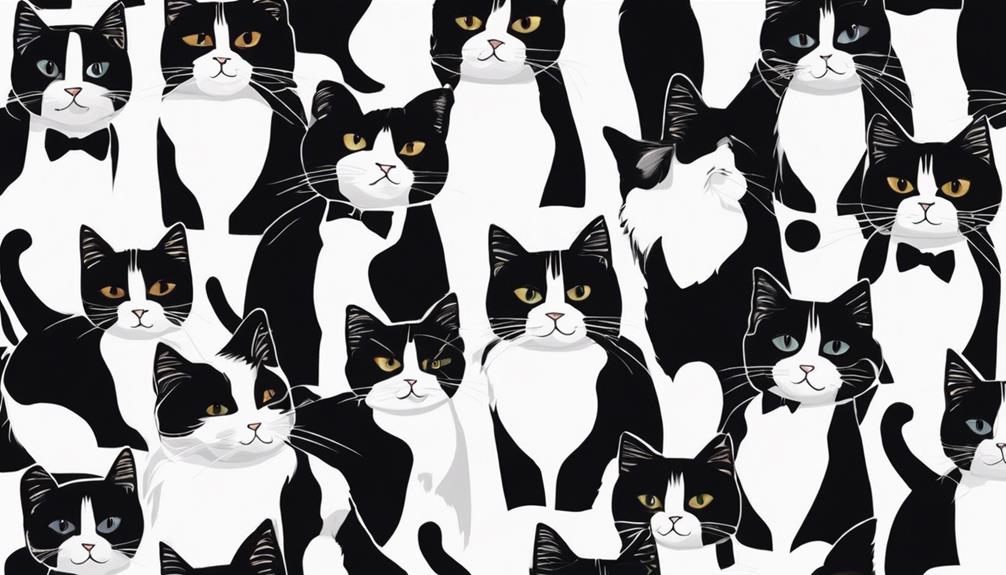
Let's explore some purrfect names inspired by tuxedo cats' whiskers that highlight their charming and elegant appearance. Tuxedo cat names influenced by whiskers can draw attention to the cat's facial features, emphasizing their unique and striking appearance. These whisker-licious names not only reflect the sophisticated look of tuxedo cats but also add a playful and endearing touch to your feline friend's identity. Naming your tuxedo cat based on their whiskers can be a delightful and creative process that strengthens the bond between you and your pet.
Here are three whisker-themed names to ponder:
- Whiskerino: This name celebrates the majestic whiskers of your tuxedo cat, emphasizing their elegance and charm.
- Smokey: A nod to the dark and light shades of your cat's coat, complementing the whiskers that frame their face.
- Panda: Inspired by the black and white contrast of a panda bear, mirroring the colors of your tuxedo cat's coat and whiskers.
Frequently Asked Questions
What Should I Name My Tuxedo Cat?
We love naming tuxedo cats based on their distinct appearance and personality. Consider monikers like Oreo, Tux, or Boots to match their formal attire. Let's choose a name that captures the essence of our feline friend!
What Is a Good Name for a Black & White Cat?
When naming a black & white cat, we consider their striking coat. A tuxedo cat's contrast inspires creative names. Choose one that reflects their formal look and playful personality. It's a fun, rewarding process!
What Is the Coolest Cat Name?
The coolest cat name is one that truly captures your feline's essence. It should make you smile every time you call it. Choosing a name that feels right for both you and your cat is key.
What Is the Technical Name for a Tuxedo Cat?
We call a tuxedo cat a 'bicolor' due to its black and white coat. These cats aren't a specific breed, but their distinctive coloration sets them apart. Their genetic makeup gives them unique variations in their markings.
What Makes Tuxedo Cat Names Different from Kiki Cat Names?
Tuxedo cat names often focus on the cat’s black and white coloring, while unique Kiki cat names may highlight the cat’s personality or characteristics. Whether it’s based on their elegant appearance or playful nature, both tuxedo and Kiki cats deserve special names that reflect their individuality.
Conclusion
To sum up, did you know that tuxedo cats aren't a specific breed, but rather a coat pattern found in many different breeds? This unique black and white coloration is what sets them apart and makes them so charming.
With the top 10 tuxedo cat names provided, you're sure to find the perfect fit for your sophisticated feline friend. Whether you choose a classy, playful, or vintage-inspired name, your tuxedo cat is sure to be the talk of the town!
